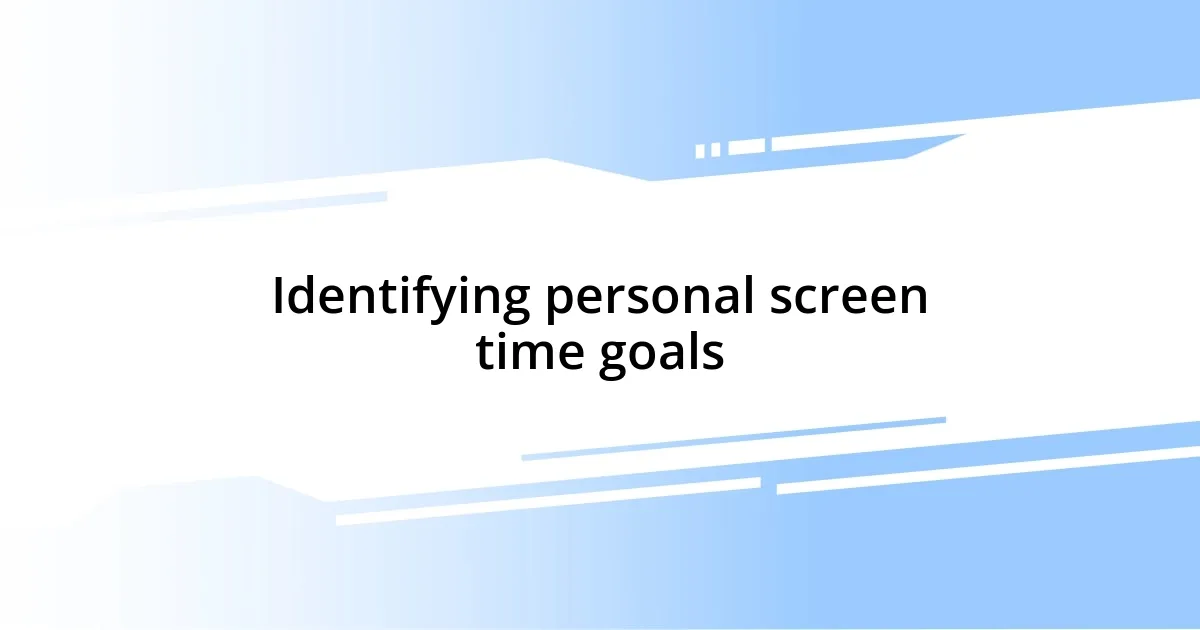Key takeaways:
- Identifying personal screen time goals requires self-reflection on productive versus unproductive usage, such as mindful reading versus mindless scrolling.
- Setting boundaries involves creating tech-free zones and utilizing apps to monitor and limit screen time, enhancing focus and connections with the real world.
- Incorporating screen-free activities like painting, hiking, and reading can improve mental health and creativity, providing a refreshing break from screens.
- Regularly evaluating and adjusting screen habits, including tracking usage and imposing limits, helps ensure screen time aligns with personal well-being and productivity goals.

Identifying personal screen time goals
Identifying personal screen time goals starts with self-reflection. I often ask myself, “What do I truly want to achieve with my screen time?” This question helps me differentiate between mindful usage, like reading articles that enrich my knowledge, and mindless scrolling that consumes precious hours without any benefit.
One technique I’ve found effective is setting specific daily limits tailored to different activities. For example, I allocate an hour for social media and two hours for work-related tasks. When I first implemented this, I was surprised at how much more focused I became. By tracking my progress, I not only noticed improvements in my productivity but also felt a sense of accomplishment when I adhered to these goals.
I also recommend considering how screen time affects your mood and well-being. After a heavy binge-watching session, I often feel drained. Recognizing this pattern has encouraged me to set limits that align with my desire for better mental health. What are you noticing about how your screen time impacts your emotions? Taking the time to pinpoint these connections can set a strong foundation for your own screen time goals.

Setting boundaries for device use
Setting boundaries for device use isn’t just about cutting down time; it’s about creating a healthier relationship with screens. I remember the chaos of trying to balance work and leisure on my devices, where notifications seemed to demand my attention constantly. To reclaim my time, I decided to establish “tech-free” zones in my day. Now, I reserve the first hour after waking up and the last hour before bed to focus on myself, whether that’s enjoying a quiet breakfast or winding down with a book. It’s remarkable how these little changes have made me feel more grounded and present.
Here are some practical steps I’ve taken to set boundaries effectively:
- Designate specific device-free times: I block off time slots when I completely disconnect from all screens.
- Use apps to limit usage: There are several apps that help track and restrict time on certain applications.
- Create a physical space for devices: Leaving my phone in another room during meals helps me engage more with those around me.
- Communicate your boundaries: Letting family and friends know about my tech-free hours has helped them to support my choices.
- Reassess regularly: I check in with myself every month to see if my boundaries still work or if I need to adjust them.
Adopting these practices has not only allowed me to enjoy my screen time more but also to savor moments of real connection in my daily life.

Incorporating screen-free activities
Incorporating screen-free activities has been a game-changer for me. I discovered that dedicating time to hobbies that don’t involve screens truly rejuvenates my mind and body. For instance, painting has become a cherished pastime; there’s something cathartic about letting my creativity flow without the distractions of notifications or “just one more episode.”
I’ve also noticed that physical activities, like hiking or biking, significantly boost my mood. It’s fascinating how a simple walk in nature can clear my mind and enhance my focus later on. Whenever I feel overwhelmed or stuck in a digital rut, I step outside for even just a short walk; the fresh air and greenery work wonders. Have you tried breaking away for even a brief time? If not, I encourage you to explore local parks or gardens; spending time outdoors can be incredibly refreshing.
Another activity I’m fond of is reading physical books. I find that this not only helps reduce my screen exposure but also enhances my imagination. When I dive into a story, my senses engage in a way that doesn’t happen when I read on a screen. What stories have you enjoyed lately? They might just hold the key to a delightful escape that screens can’t provide.
| Screen-Free Activity | Benefits |
|---|---|
| Painting | Releases creativity, reduces stress |
| Hiking | Boosts mood, enhances focus |
| Reading | Improves imagination, reduces fatigue |

Utilizing apps for screen management
Utilizing apps for screen management has been a revelation in my journey toward balance. I remember feeling overwhelmed as notifications buzzed incessantly, pulling my attention in every direction. That’s when I stumbled upon apps like Forest and Stay Focused. These tools allow me to set specific limits on my usage. I often find it satisfying to see my progress, almost like checking off a to-do list, which reinforces my commitment to staying mindful about my screen time.
I’ve also experimented with settings on my devices. Adjusting screen time settings in my phone’s operating system helped me gain insights into my habits. Did you know that seeing how much time I spend on certain apps helped me realize I was unintentionally scrolling through social media for hours? It was eye-opening to say the least. Now, I routinely reassess and tweak the limitations based on my goals, creating a personalized digital ecosystem that aligns with my life rather than controlling it.
In my experience, integrating these apps not only helps me establish boundaries but also encourages a deeper sense of purpose in my daily activities. For example, I love using the Pomodoro Technique on my phone with a dedicated app. It prompts me to take short breaks, making it easier to shift away from my screen for a moment and recharge. How often do you truly take a break while working? I’ve learned that stepping away, even for just five minutes, can refresh my mind and bring clarity, making the screen time I do engage in more productive and enjoyable.

Evaluating and adjusting screen habits
Evaluating my screen habits has always been an enlightening experience. I recall a time when I simply accepted my usage without question, believing I was productive just because I was busy scrolling. It wasn’t until I took a moment to track my usage that I realized I was spending an alarming amount of time on mindless activities. Have you ever taken the time to look at your screen time statistics? It can be quite revealing, almost like shining a flashlight on hidden corners of your routine.
Adjusting my screen habits has become a rewarding practice. After identifying the apps that sucked most of my time, I made a conscious effort to limit those intrusive distractions. I remember reducing my social media time by implementing a hard stop at 30 minutes a day. The initial frustration was palpable, but as I adjusted, I found I had more time to invest in things I truly love—like photography. What cool hobbies might you uncover once you adjust your screens down a notch?
I’ve learned that flexibility is key when evaluating and adjusting my habits. Not every week is the same; some days I crave more screen time for relaxation or to catch up on my favorite shows. Other times, I embrace a digital detox fully, where the focus shifts back to the world around me. It’s the ebb and flow that keeps things interesting. I invite you to reflect—how willing are you to try those adjustments for the sake of your well-being? Balancing screen time is as much about knowing when to dive in as it is about knowing when to step back.














